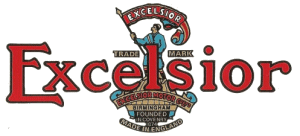


The new twin British Excelsior is fitted with an 8 h.p. J.A.P. 85.5 X 83 mm. engine, Sturmey-Archer gear box, and all-chain transmission

The Excelsior sidecar is designed to accommodate a juvenile on a sliding adjustable seat.
DESIGNED as a family sidecar, the new 8 h.p. British Excelsior is one which will appeal to many motor cyclists who have found the average medium-powered machine too small tor their requirements. While there is nothing in the machine which departs from the conventional. The new model strikes one as being a "clean" design, in which accessibility has been well considered. Provision is made for fitting a dynamo between the "seat" tube and the rear mudguard, and the gear box bracket is upswept in. order that the ground clearance shall be suitable for Overseas requirements. This is no less than 6in. at the lowest point, yet, with the 28 x Sin. tyres, the power and gear units do not appear to be unduly high.
The engine is the 8 h.p. J.A.P. provided with B. and B. pilot jet carburetter and M-L magneto, and driving through a Sturmey-Archer gear box by chains throughout. The cylinders are readily detachable without disturbing the rest of the engine, and well-made and easily removable cases enclose the chains.
Included in the general equipment of the cycle portion of the outfit are Druid Mark II. forks, aluminium footboards, front and rear stands, American type rims, and detachable wheels. Although not shown in the illustrations, it is intended that the sidecar lugs shall be integral with the frame.
The Sidecar.
Appreciating the requirements of the average user of big twin sidecars, the makers of the British Excelsior are standardising an extra large sidecar body which, when desired, will be supplied with an adjustable seat for a juvenile. This seat slides on two-slotted metal guides fixed to the side and the door of the body.
The price of the machine with sidecar is £150, or, with hood screen and additional seat, £152. A dynamo lighting set with electric horn costs a further £25, while a spare wheel with tyre is catalogued at £8.
The Motor Cycle, August 14th 1919, p165